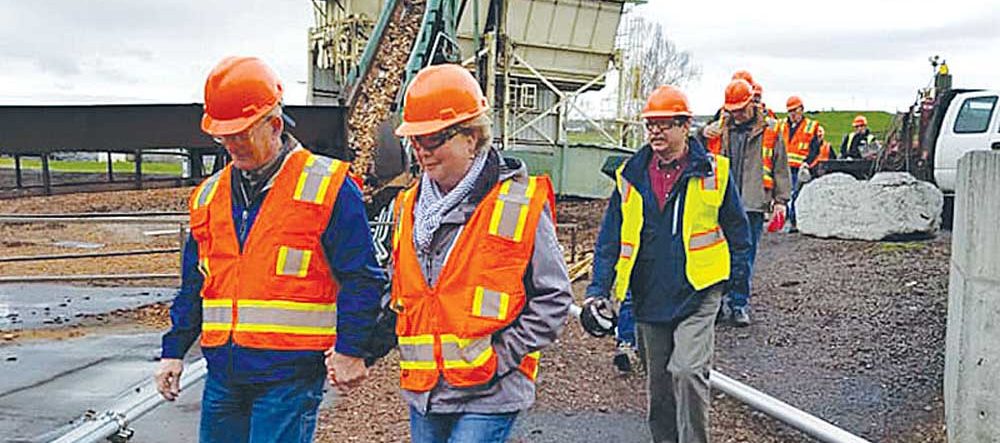Critics lash out at habitat conservation plan for state forests
Published 4:15 pm Wednesday, March 8, 2023

- Betsy Johnson, a former Oregon state senator and 2022 gubernatorial candidate, spoke against a proposed habitat conservation plan that would restrict logging on 640,000 acres of state forestland west of the Cascades.
CORVALLIS, Ore. — A crowd of about 100 people gathered at the Oregon Board of Forestry’s March 8 meeting to blast a proposed habitat conservation plan that would restrict logging on 640,000 acres of state forests west of the Cascade Range.
The meeting was at the LaSells Stewart Center on the campus of Oregon State University in Corvallis.
Opponents of the plan, or HCP, testified that reductions in timber harvest will threaten high-paying jobs and decrease revenue for essential services in rural communities, including schools, public safety, fire protection and health care.
While discussion of the HCP was not on the board’s agenda, students, loggers, industry representatives and elected officials took turns speaking during an open public comment session, urging the Department of Forestry to reconsider the plan.
“These are lifetime decisions,” said Courtney Bangs, a Clatsop County commissioner. “Take time, do the work (and) get the best deal, before these communities are gutted.”
Endangered species
ODF started work on the HCP in 2018 as a way to balance timber harvest with protections for endangered species for the next seven decades.
The plan is essentially an agreement between the state and two federal agencies — NOAA Fisheries and the U.S. Fish and Wildlife Service — that the forests will be managed to mitigate harm to 17 species that are either listed as endangered, or could be listed.
That list includes the northern spotted owl, marbled murrelet, coastal marten, red tree vole, three different salamanders and 10 species of fish.
In exchange, the HCP protects land managers from potential lawsuits in cases of “incidental take” if management activities result in killing species or destroying habitat.
But the state also has an obligation to harvest timber on state forests as a source of revenue for 15 Forest Trust Land counties. About two-thirds of the money from these timber sales goes to taxing districts in the counties, and ODF keeps the remaining one-third for its budget.
Most of the 640,000 acres in question are in Clatsop and Tillamook counties, along the north Oregon coast.
Reduced harvest
The state initially estimated it would harvest between 225.4 million and 226.2 million board-feet of timber annually after the plan is implemented.
However, new figures released in February prescribed a harvest of 165 million to 182.5 million board-feet annually for the next two years. That 27% reduction has raised alarm from officials who worry the lost revenue will have devastating effects on the rural economy.
State Rep. Cyrus Javadi, a Republican whose district includes Clatsop and Tillamook counties, said the current proposal came as a disappointment and fails to strike the right balance between environmental and economic priorities.
“I urge you to direct ODF to improve the HCP and increase timber harvest volumes before it’s too late,” Javadi told the Board of Forestry.
Kevin Leahy, executive director of Clatsop Economic Development Resources and associate vice president at Clatsop Community College, said the county stands to lose $8.5 million annually under the HCP, including $600,000 for the college.
Furthermore, the loss of timber harvest would potentially eliminate 275 jobs in the county’s forest products sector, Leahy said.
The average annual wage for these jobs is $70,599, which is 55% higher than the county’s overall annual wage of $45,498, according to the state Employment Department.
“It would have a tsunami effect on our local economy,” Leahy said of the plan.
Mark Standley, vice president of Bighorn Logging in Banks, Ore., said he is already developing a backup plan for his 70 employees, reaching out to timber companies in Washington and Idaho seeking contract work.
“That would not be my ideal outcome, but I also need to make sure our employees have an opportunity to earn income for their families in a profession they love,” Standley said. “We should be building up the next generation of loggers, not setting them up for failure.”
House GOP letter
The issue has caught the attention of the Oregon House Republican Caucus, which sent letter to Gov. Tina Kotek arguing the HCP should be reconsidered.
“While our caucus largely supports the intent of the HCP and reasonable conservation measures, we want to ensure that our forests continue to be valuable economic and societal resources for communities,” the letter states.
The current plan is “heavy on protection and light on economic realism,” the caucus wrote.
Betsy Johnson, a former state senator and gubernatorial candidate from Scappoose, said communities in northwest Oregon “have gone from incredulous to furious” over how the HCP has been handled.
“To call this an open and inclusive process is bureaucratic hogwash,” Johnson said. “Rural Oregonians do feel this plan is being shoved down their throats.”
Johnson said the region needs to maintain its forest products infrastructure “so our rural communities can continue to be places where people can live, work and raise a family.”
Not everyone at the Board of Forestry meeting opposed the HCP. A few representatives of environmental groups praised ODF’s work on the plan, and encouraged the board to move forward without delay.
Joe Liebezeit, statewide conservation director for Portland Audubon, said declining populations of endangered species should serve as fair warning.
“Please don’t be swayed by timber interests that seek to maximize their profits at the expense of counties that will remain at the vagaries of a fluctuating timber market to support their essential services,” Liebezeit said. “We need a new model for rural counties that diversifies support beyond timber revenue.”









